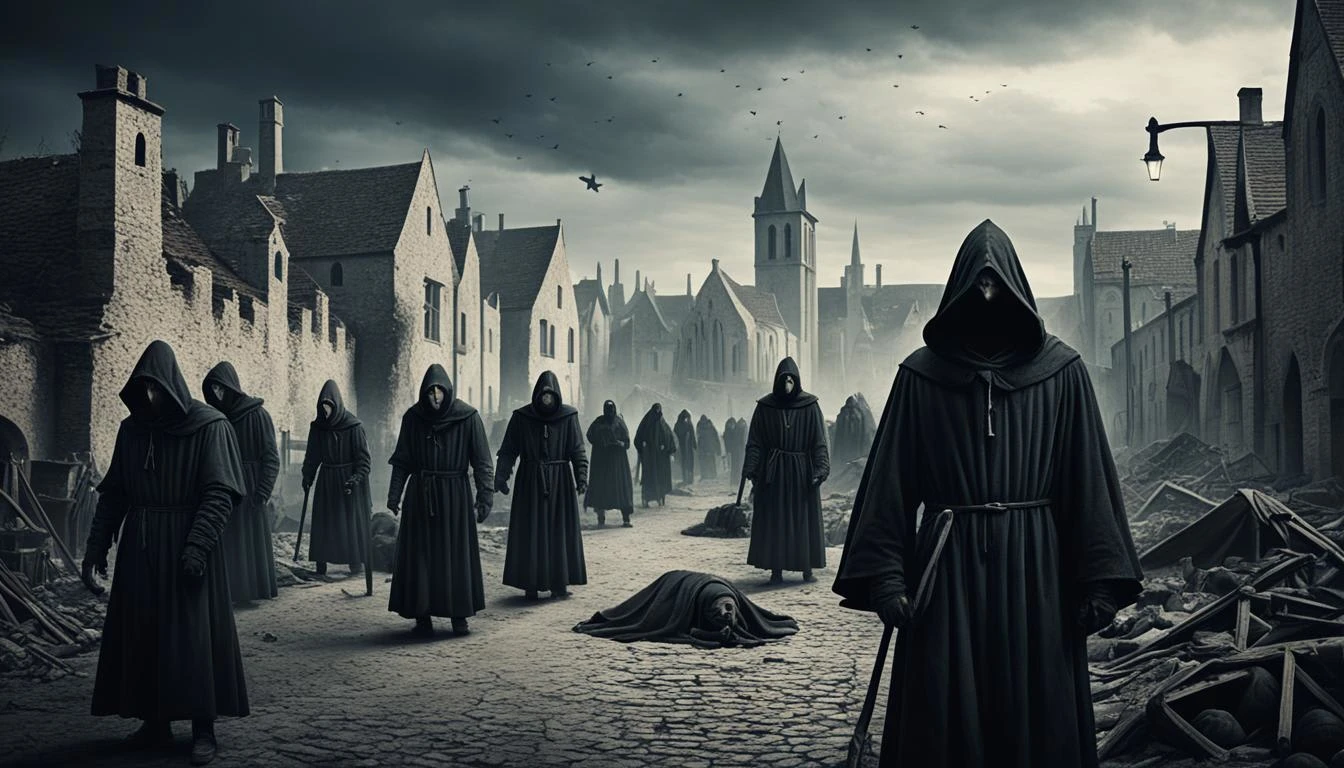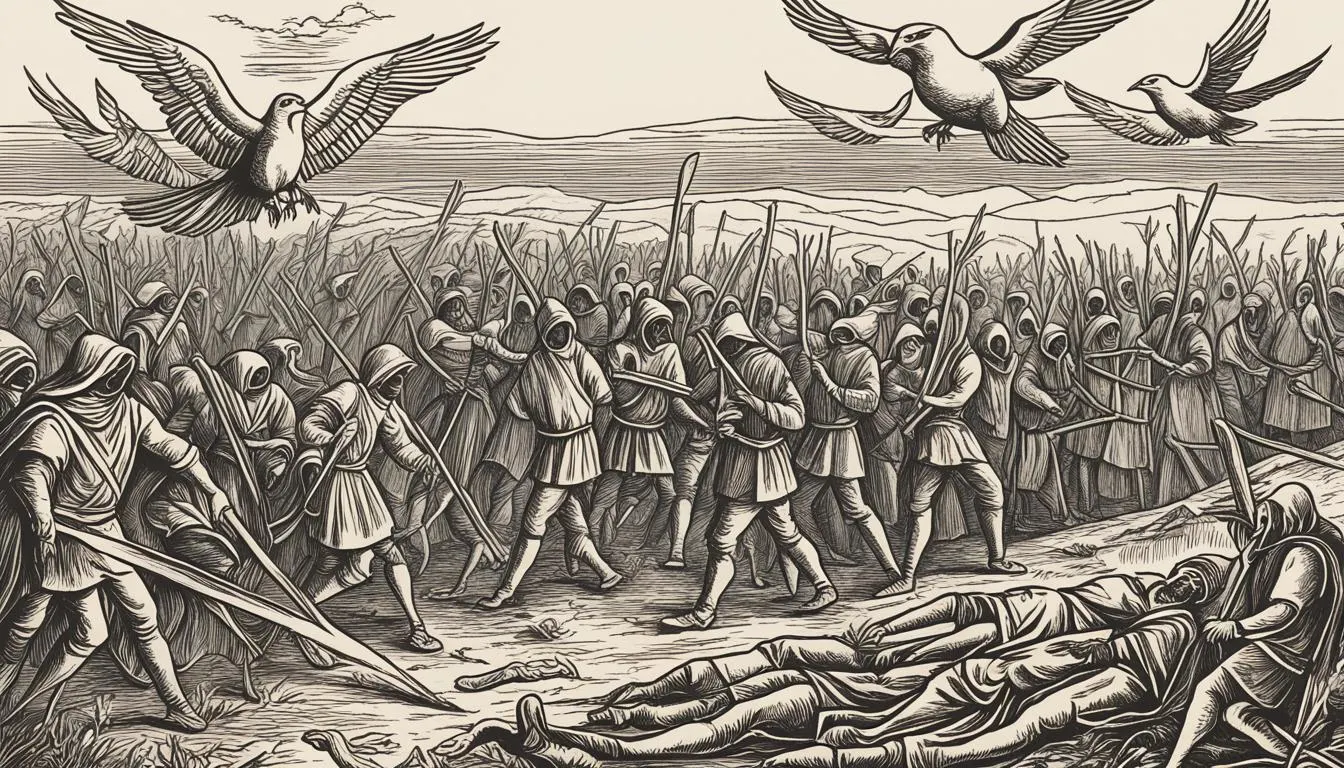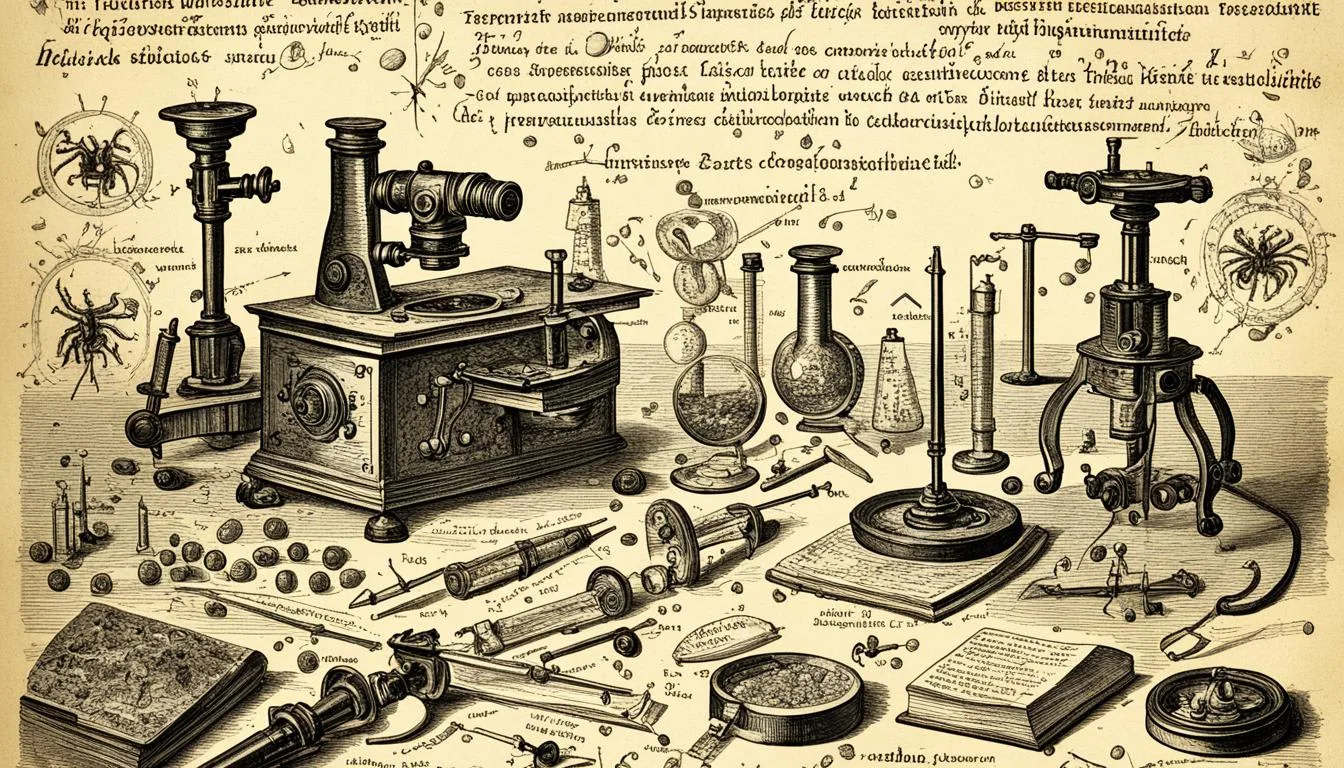The Black Death
The Black Death (1347-1351): Europe's Deadly Plague
The Black Death was a bubonic plague that hit Europe hard from 1347 to 13511. It killed around 25 to 50 million people. This was about half of Europe's people in the 14th century. A bacterium called Yersinia pestis caused it. It spread through fleas and the air. The Black Death changed Europe greatly, affecting its people, economy, and culture. It was the start of Europe facing plague pandemics.

Key Takeaways
The Black Death was a devastating bubonic plague pandemic that ravaged Europe from 1347 to 1351.
2. It was one of the most fatal pandemics in human history, killing an estimated 25 to 50 million people.
3. The disease is caused by the bacterium Yersinia pestis and spread through fleas and airborne transmission.
4. The Black Death had far-reaching population, economic, and cultural impacts in Europe.
5. The Black Death marked the beginning of the second plague pandemic.
What Was the Black Death?
The Black Death was a devastating plague in the mid-14th century. It spread through Europe and killed millions. This horrible disease was caused by a bacterium known as Yersinia pestis. It mainly spread through flea bites and through the air.
The Bubonic Plague Ravages Europe
The plague spread fast across Europe. It moved along trade paths. Rats and their fleas helped it spread to new areas. Between 1346 and 1353, about 60% of Florence’s people died. Similar losses were felt in Siena. The disease hit hard and quick, with people dying within days of showing symptoms.
Once infected, people started showing signs within three to five days. And then, in 80% of cases, they died within the next few days after.
Symptoms and Spread of the Deadly Disease
Victims suffered from severe symptoms. They got huge, painful buboes. Fever, chills, vomiting, and diarrhea were common too. The disease had a huge impact, spreading quickly through both cities and the countryside.
The epidemic's detection varied. In the countryside, it could take up to forty days. In larger cities, it was slower, up to eight weeks. Ships also carried the plague far and wide. This happened when rat fleas survived on the rats' fur and then moved to new areas on ships.
"Evidence extracted from plague burials in French cemeteries dating from 1348-1590 has provided genetic confirmation of Yersinia pestis, the bacterium causing bubonic plague, as the causal agent of the Black Death."
In rural areas, more people got sick and died than in cities. This was because they were closer to rats. The Black Death probably started in the steppes, between the rivers Don and Volga. This area was under the control of the Mongol khanate of the Golden Horde. The plague then spread quickly to Europe through the Silk Road.
Origins and Theories of the Plague
In the 14th century, the Black Death hit Europe, causing a major pandemic. Its exact start remains a topic of discussion among experts. Studies show this disease likely began in the Tian Shan mountains, which lie on the Kyrgyzstan and China border, about 2,600 years ago. The pandemic might have reached Europe first during a siege in Kaffa, Crimea, by the Golden Horde army in 1347. From there, it is believed to have spread across Europe via trade ships.
People once thought the Black Death came from bad astrological signs or by God's wrath, or even through 'bad air.' But now, science tells us it was the bacterium Yersinia pestis that spread through fleas and rats.
Plague Theories - Explanation
Astrological Conjunctions - Suggesting planet and star alignment was the cause.
Divine Punishment - Believing the plague was God's punishment for human wrong doings.
Miasmas or "Bad Air" - Thinking that disease came from toxic airs.
Yersinia pestis - The fact that a bacterium, Yersinia pestis, spread through fleas and rats caused the plague.
The Black Death changed Europe massively, affecting its societies, economies, and cultures. Today, its start and how it spread remain topics of ongoing study and debate as experts try to understand this critical event in history.
The Black Death (1347-1351)
How the Plague Arrived in Europe
The Black Death hit Europe in 1347 through Genoese ships. These ships were carrying rats and fleas that were infected. The plague then spread fast, through the Mediterranean, hitting places like France, Spain, England, and Germany by the next year. The disease was devastating, killing a huge number of people in Europe alone.
The Devastating Toll on European Population
The Black Death led to massive loss of life across Europe. It had deep impacts on society, economy, and culture. The death toll varied, but was very high. Records show it killed between one-eighth and two-thirds of the population, depending on the area. Chronicler Jean Froissart said a third of Europe's people died during this time, which matches with what we see in records.
By 1400, England's population was just half of what it was before the Black Death. This led to the vanishing of about 1,000 villages. In all, around 25 million people in Europe died because of the Black Death. The land's population didn't recover right away, not until the early 16th century. China and India also suffered greatly during this period.
The Black Death affected both wealthy and impoverished. It touched both urban and rural areas, making no distinctions. The plague had huge impacts, shaping Europe's future in major ways.

Impact and Aftermath of the Pandemic
The Black Death from 1347 to 1351 changed Europe forever. It caused major social, economic, and cultural shifts. Around 25 million people died in Europe because of this plague. This huge loss of life weakened the feudal system and set the stage for the Renaissance.
Social, Economic, and Cultural Effects
Many lost their lives in the Black Death, leading to a shortage of workers. This helped the lower classes gain power and weakened the grip of the rich. The survivors could ask for better pay and more freedom. The upper classes seemed to suffer less, making tensions between classes worse.
The plague hit trade hard, causing prices to spike and poverty to rise. Places like Bremen and Nuremberg in Germany saw their populations drop by more than half and a tenth. Still, it reduced the wealth gap in German-speaking areas.
Religions were challenged by the Black Death; blame often fell on minority groups like Jews. But in some places, people of different faiths united to pray during the crisis. Artists and writers also began to focus on themes of mortality, setting the scene for the Renaissance.
The Black Death was a turning point for Europe, leading to the end of feudalism and the start of the Renaissance. It showed the world how deadly diseases can change society forever.
"The unprecedented stock market reaction to COVID-19 has been observed, indicating substantial market volatility during the pandemic."
Today, as COVID-19 continues, we can learn from the Black Death's effects. It teaches us about the big impacts of health crises on society.
The Persistence of the Plague
The Black Death pandemic of 1347-1351 was a dark time. It was not the plague's last attack on Europe. Plague outbreaks spanned to the early 19th century, striking every few generations. Even three hundred years after the first pandemic, Europe's population struggled to return to previous levels. The plague's ongoing threats caused major shifts in society, the economy, and population numbers.
Plague outbreaks, from the bacteria Yersinia pestis, have haunted humanity. Evidence shows this plague strain existed 5,000 years ago in Eurasia. The cycle of pandemics, including the Great Plague of London in 1665, highlights this terror's lasting impact.
Many factors, like climate and fleas, fueled black death comebacks14. Scholars believe the climate helped spread the Black Death to Europe and brought it back several times. Fleas, among other things, were key in the Second Pandemic's spread in Europe.
Studying ancient skeletons offers a window into plague demographics and health. This data includes ages, sex, health, and more, bringing the past to life. It helps us understand the plague's lasting effects on Europe.
In today's world, the plague hasn't disappeared. The CDC noted human plague cases in the U.S. from 1970 to 2018, showing it's still around. The global spread of the plague in recent years reminds us it can affect anyone. Though we have better ways to fight it now, the plague's adaptability showcases why we must not let our guard down. Continuous research is crucial in managing the risk it poses.
Names and Descriptions of the Black Death
The Black Death hit Europe in the 14th century. It was called by many names then. These included pestis (pestilence), pestilentia (pestilence), epidemia (epidemic), and mortalitas (mortality). Some also called it "the pestilence," "the great pestilence," or "the great death."
Origins of the Term "Black Death"
The name "Black Death" came about much later, in the 18th century. This name became known thanks to writers from Sweden and Denmark. Before then, "black death" was used for deaths in general, because "black" shows how serious and dark death is.
The Black Death brought on many symptoms. People had swollen glands, fever, chills, and headaches. They also coughed up blood, felt short of breath, and might not think clearly. Nearly half of people who got sick from the Black Death didn't make it.
It spread mainly through the bubonic plague. This type had a death rate between 30% and 75%. It could also turn into the pneumonic plague, which was almost always deadly, or the septicemic plague, which was certain to kill.
This pandemic was hugely tragic, killing at least 25 million people in Europe between 1347 and 1352. Some places lost up to 60% of their people. For instance, half of Paris perished, and Florence lost more than half its population.
The Black Death changed everything in Europe. It led to big changes in how society, the economy, and culture worked. The period after the plague was a new chapter for Europe.
Previous Plague Outbreaks in History
The Black Death in the 14th century stands out as one of the worst pandemics ever. Yet, it wasn't the first to strike people all over the world. Studies show a disease caused by Yersinia pestis may have infected humans as far back as the 4th millennium BCE. The first major plague we know of was the Plague of Justinian from 541 to 542 CE, covering the Byzantine Empire and the Mediterranean.
The First Plague Pandemic
The Justinian plague was the inaugural pandemic, caused by Yersinia pestis. It's said to have killed 30 to 50 million people, almost half of the world's population then. In 542 CE, up to 10,000 people died every day in Constantinople at its worst. The disaster shook societies and economies, even leading to the end of Justinian's rule.
Disease outbreaks happened now and then before the Black Death's horrors in the 14th century. The Black Death, striking from 1347 to 1351, killed 25 to 30 million in Europe. This time, 30% to 60% of Europeans lost their lives. It was part of the second large plague pandemic spanning from the 14th to 18th centuries.
Thankfully, today we have better hygiene and medicines to fight plagues. This means a new plague would not be as catastrophic as before. But the bacteria that causes the plague still exists in rodents all over the world. So, the threat remains.

"The Black Death alone killed 50 million Europeans between 1347 and 1351."
Modern Understanding of the Plague
The Black Death and plague are well-studied today thanks to scientists like Alexandre Yersin. He found the Yersinia pestis bacterium in 1894 during a Hong Kong epidemic. We now know how fleas and rats spread the disease and how it infects people.
Scientific Discoveries and Treatments
Plague still happens now, mainly in Asia, Africa, and the Americas. But, thanks to clean living and medicine, its effects are less severe. However, it's a big worry for health experts, with 1,000 to 3,000 cases a year worldwide.
The Black Death killed one-third of Europe from 1347 to 1350. In 1348-49, half of Europe's people died. Bubonic plague killed about half the people it infected, and pneumonic plague almost always led to death. At that time, England had 6 million people, and 2 to 3 million died.
Alexandre Yersin found the plague bacteria in 1894. Later research showed how fleas and rats spread it, and how it infects people. This knowledge unlocked better treatments and ways to stop the disease.
After the Black Death, new devices like clocks, guns, and glasses appeared. The printing press also started. It helped Europe grow again by spreading information.
Today, plague is not as dangerous thanks to clean living and medicine. But, it's still a big worry for health. There are 1,000 to 3,000 cases around the world every year. Health experts always look for new ways to beat this old enemy, the "modern plague."
Conclusion
The Black Death was a huge bubonic plague outbreak that hit Europe and the Mediterranean from 1347 to 1351. It killed 25 to 50 million people. This changed Europe's history forever24. It was caused by a germ, Yersinia pestis, and spread fast through trade. This caused major social, economic, and cultural changes. Even though it wasn't the first plague, it was very deadly and shook up European society.
This pandemic ran from 1347 until 1351. It wiped out about one-third of the people in Europe. It hit Britain in 1348, killing 30 to 45% of its people. This disaster affected trade and how society was structured. The Black Death was so bad, up to 70% of those who got sick died in five days. It made about 1,000 villages completely vanish from Europe.
The Black Death's impact is still being studied today. It arrived just as the high Middle Ages were ending, marking the start of a tough economic period from 1300 to 1500. Although diseases today are scary, we've learned how to fight them together. COVID-19 has shown us that sharing what we know can help stop diseases from spreading.
-By Praveen Shankar
FAQ
What was the Black Death?
The Black Death was a terrible disease that hit Europe from 1347 to 1351. It's known as one of the deadliest out there. Estimates suggest it killed 25-50 million people. This was about half of Europe's population back then. The sickness came from the Yersinia pestis bacterium and was spread by fleas and in the air.
How did the Black Death spread?
The Black Death moved quickly in Europe thanks to trade routes. Infected rats and fleas on ships started it. Then, it spread from port cities further inland. Flea bites and even the air could pass the disease on.
What were the symptoms of the Black Death?
The Black Death showed up in people with swollen and painful lumps, fever, and chills. They also felt sick, had diarrhea, and their bodies hurt a lot. Sadly, many died very soon after getting sick.
What were the origins of the Black Death?
The start of the Black Death is still argued over. Yet, looking at genes suggests it began in mountains between Kyrgyzstan and China. This was about 2,600 years ago. Europe likely saw the disease first when the Golden Horde attacked Kaffa in Crimea in 1347.
When and where did the Black Death first arrive in Europe?
The Black Death might have come to Europe in 1347. That's when infected rats and fleas got off Genoese ships in Sicily. It then quickly moved across the Mediterranean to France, Spain, and other places by 1348.
What were the impacts of the Black Death on European society?
The Black Death changed Europe in big ways. So many people died that there weren't enough workers. This broke down the old system and let people move up in society. It also brought hard times for businesses, causing prices to go up and making many poor. People started questioning religion, treated some groups badly, and saw new art and writing about death everywhere.
Did the Black Death have lasting effects on Europe?
The Black Death's effects lasted way beyond the years 1347 to 1351. It kept coming back every few generations until the 19th century. It took until 1500 for Europe’s population to get back to what it was. Many say it was one of the things that made the Middle Ages so hard.
How did the Black Death get its name?
The name "Black Death" didn't show up until the 18th century. That's when some writers from Sweden and Denmark used it. Even before then, people sometimes used "black" to talk about deadly diseases. They did that because black often means something bad or scary in older languages.
Was the Black Death the first plague pandemic in history?
No, the Black Death wasn't the first big plague event for humans. Our genes show that we might have gotten plague much earlier. The first one we know a lot about is the Plague of Justinian. This one hit the Mediterranean area and the Byzantine Empire in 541-542 CE.
How do we understand the Black Death today?
Today, we know way more about the Black Death, thanks to research. Alexandre Yersin found the germ that causes it in 1894. We now understand how it spreads through rats and fleas. Even though plague is still a risk, we can fight it better with clean habits and medicine.
Like this project
Posted Jun 27, 2024
The Horrors of Europe in 1347-1351 popularly known as "The Black Death" -By Praveen Shankar
Likes
0
Views
34




